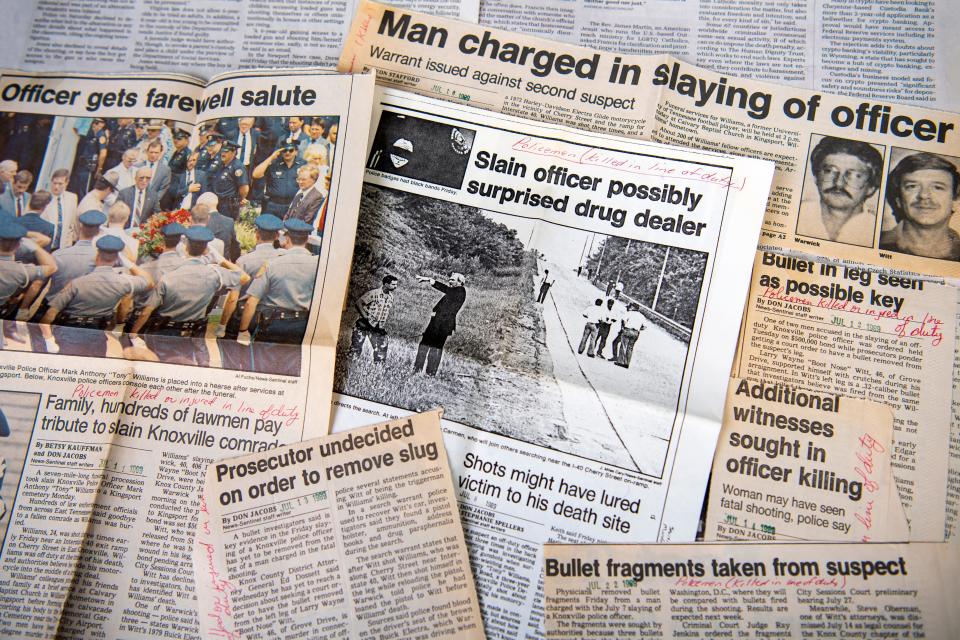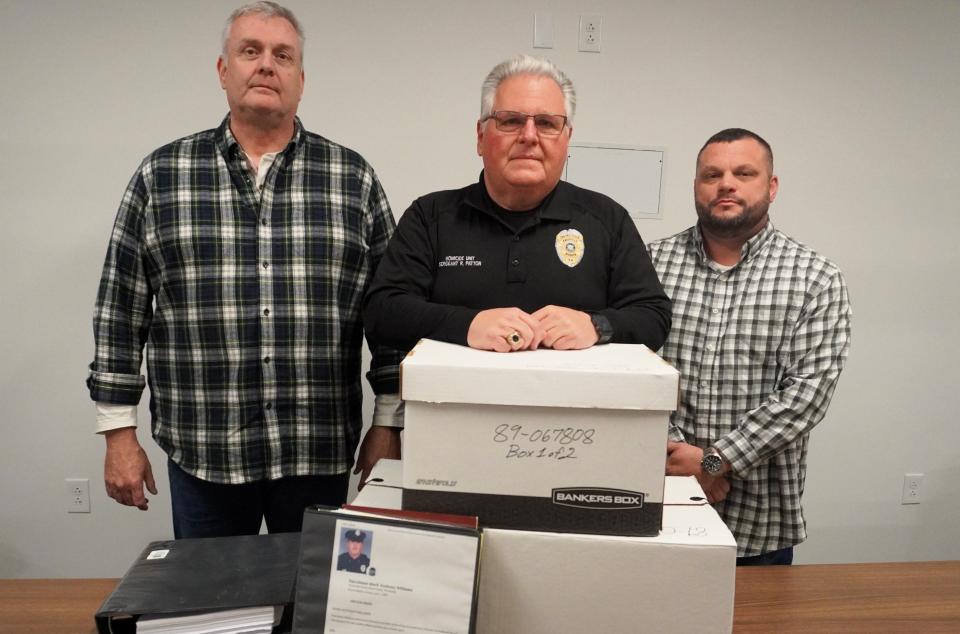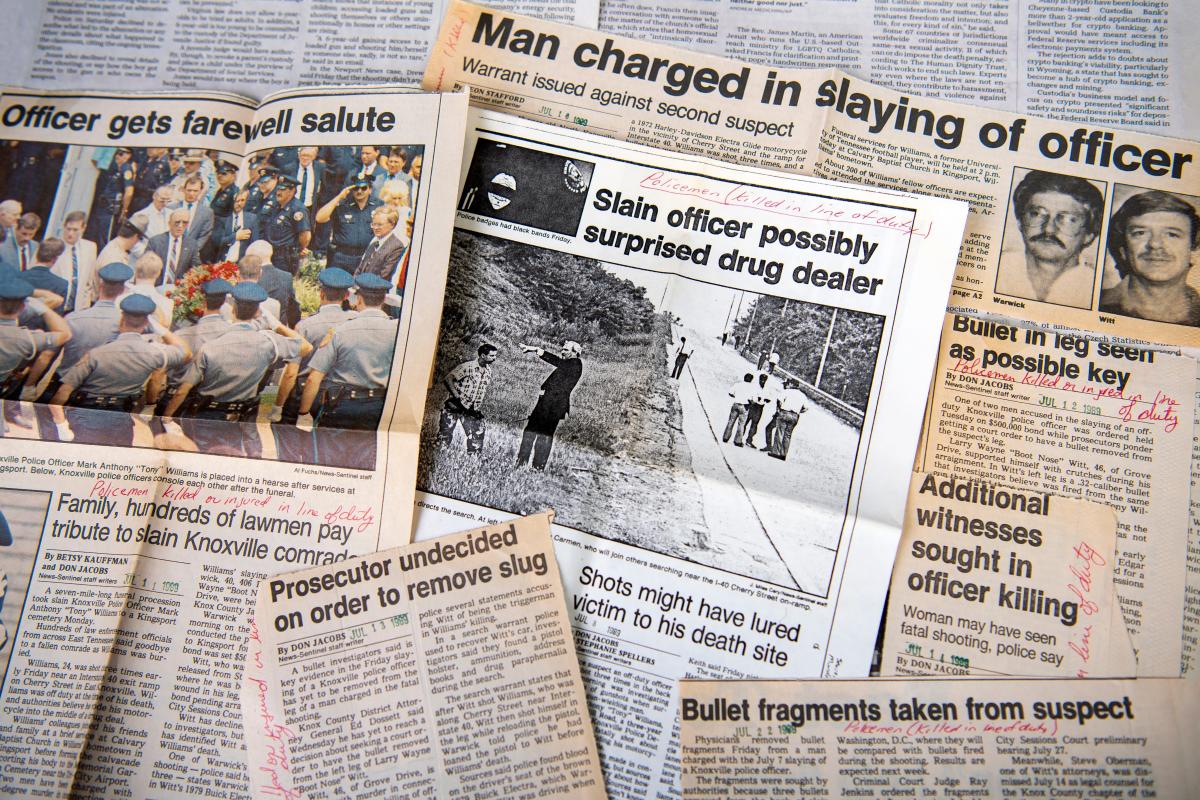Knoxville police detectives knew who gunned down one of their own in the early morning hours of July 7, 1989. They just couldn’t prove it, at least not to the point of putting together a case for prosecution.
So Johnnie Warwick went free, at least for a while. Although law enforcement was not able to take him to trial for the shooting death of Mark Anthony “Tony” Williams, Warwick was convicted in 1997 on federal drug and gun charges and was sentenced to 45 years in prison.
Warwick was granted compassionate leave in 2020 and died late in 2023 − just before a reinvigorated case could be presented to the grand jury.
Now Knoxville investigators have closed the book on Williams’ murder, posthumously finding Warwick was responsible.
“Members of the KPD Homicide Unit and Organized Crime Unit presented the case to a grand jury in December (2023),” a police department spokesperson said in a late January press release. The grand jury returned a finding that “Johnny (sic) Edgar Warwick, on or about the 7th day of July, 1989, did unlawfully, intentionally, deliberately and with premeditation kill Anthony Williams.”
Here’s a look back at the murder that shocked the community nearly 35 years ago.
How was Knoxville Police Officer Tony Williams killed?
On July 7, 1989, KPD patrol officer Mark Anthony “Tony” Williams was shot while riding his motorcycle on Cherry Street near I-40. Williams was off duty at the time of his murder.
Williams was just 24, a three-year veteran of the police department, and had only recently purchased the 1972 Harley-Davidson, the News Sentinel reported. Sources at the time told law enforcement the suspects likely did not know Williams was a police officer, but fired at him because he was intruding on a drug deal.
Williams was shot three times in the back around 12:30 a.m. Police believed he tried to get on I-40 to go to the hospital before turning around and eventually collapsing on Cherry Street.
How were the suspects in the shooting identified?
It didn’t take long for the Knoxville Police Department to identity two suspects. Warwick, 40 at the time, had been arrested in Lake City on drunken driving charges just five hours after the shooting but was released after he posted bond. A gun recovered from Warwick’s car in Lake City was connected to Williams’ murder.
Larry Wayne “Boot Nose” Witt, 46 at the time, was linked to the crime after he sought treatment for a gunshot wound to the leg. Both men subsequently were charged with first-degree murder.

Warwick changed his story multiple times, admitting the two men were together but insisting he had loaned Witt his gun and that Witt was the one who pulled the trigger.
Warwick also claimed that Witt shot himself in the leg while he was reloading, then had two friends try to dig the bullet out of his leg with a coat hanger before seeking treatment at a local hospital.
Why did Warwick and Will never stand trial for Williams’ murder?
Less than a month after the shooting, a Knox County judge dismissed the murder charge against Witt, ruling prosecutors had not provided any evidence that Witt was involved in the shooting.
Witt, who had a 1970 involuntary manslaughter conviction reduced from a prior murder charge in Atlanta, was still considered a suspect, however.
The charge against Warwick was forwarded to a grand jury but was never heard.
One issue with the case? The bullet fragments recovered from Williams’ body and from Witt’s leg (after a court-ordered surgery) could not be matched to Warwick’s gun.
In April 1990, new bullet fragments were found that month near the shooting site, but by July of that year, a News Sentinel reporter characterized the investigation as a “Twilight Zone.”
What happened to the two suspects in Williams’ death?
In 1996, Warwick was arrested in a sting that involved him trying to hire an undercover officer to beat up Witt. During the sting, Warwick repeatedly referred to Williams’ murder in recorded conversations but continued to claim Witt was responsible.
He eventually took a plea agreement on federal marijuana distribution and gun charges and was sentenced to 45 years.
Warwick was granted compassionate release due to his health in December 2020, court records state. He died sometime around Nov. 1, 2023, at the age of 74.
Witt, meanwhile, faced his own set of federal drug charges in 1997, for distributing cocaine. He took a plea and was sentenced to 50 months, court records state. He also has died, police confirmed.
What happened to the Williams investigation?
After the case remained dormant for years, Homicide Unit Sgt. Rodney Patton reinvigorated the investigation. It was more personal than most cases to Patton, who went through the police academy with Williams. The two also attended SWAT training and were on the team together.
At the time of Williams’ murder, Patton was on a 30-day rotation working with a repeat offenders program; he said he was set to go back to patrol shortly after the shooting. Detectives at the time worked the case nonstop, Patton remembered.
Even after the prosecution petered out, work on the murder continued.
“We don’t like the term cold case,” Patton said. “We go with unsolved, because even our unsolved cases that we have now, that are years and years old, we’re going through and reassigning those to our homicide investigators and violent crime detectives, to take another look at these cases with fresh eyes.”


Detectives collaborated with retired FBI agent to take another look
It wasn’t until Patton transferred to the major crimes unit in 2017 that he was able to revisit Williams’ murder.
“It took a while to pull everything together. I had to re-read everything,” Patton said, adding he eventually reached out to retired FBI Special Agent Paul Hughes.
The FBI was heavily involved from the beginning, they did a lot of investigative work on the case,” he said. “It was still an open case with them, so he was able to jump in. We tracked down witnesses that were still alive and re-interviewed some of them.”
In mid-2023, organized crime detective Brandon Stryker joined the team, Patton, said, adding, “He was able to bring in some new ideas, some new ways for us to look at the evidence.”
That evidence, Patton said, included multiple volumes of notes and reports, Williams’ clothing from that night and the murder weapon.
The weapon had always been problematic.
“The gun is not a high-quality gun, and the rifling (the grooves inside the barrel) was not that great,” Patton said. “The bullets used, the rounds were soft lead and that did not lend itself to keeping grooves. That was the issue back then. We had an expert look at the gun again and came up with the same conclusion, even with today’s technology, that it would be very difficult” to match the gun to the bullets.
What new evidence helped put the case to the grand jury?
Technology definitely played a part in bringing the nearly 35-year-old case to the grand jury.
Stryker suggesting using a drone to give a better overall view of the crime scene, including the route Williams took and the way he came back down the interstate. And in September, the investigators closed portions of Cherry Street near I-40 to complete a FARO forensic scan of the area, which captured comprehensive and detailed 3D images of the crime scenes.
“It’s been almost 35 years since Officer Williams was murdered, which has left Tony’s family and our department without any real closure,” Chief of Police Paul Noel said in an Oct. 11 Facebook post. “I urge anyone with information that could potentially assist our efforts to bring closure to Tony’s family to contact the Homicide Unit.”
Some of the legwork, however, was just being able to look at the evidence in a new way.
“Hughes and I, we went to talk to Mr. Warwick and he agreed to come in and give an interview,” Patton said. “We were able to lock him into his statements of, this is how it happened. … He kept giving us different versions of the events that night, but he always came back to the fact there were just the two of them in the car and that Witt was the driver.”
In what proved to be a key factor, the team was able to locate a car that was similar to the vehicle that Witt and Warwick were riding in that night.
“We were able to prove there was no way it could have happened that way, with Witt being the shooter, with where everyone was located,” Patton said.
Williams murder suspect died in hospice care before case went to grand jury
The team had put together the grand jury presentment and even had a hearing date scheduled, but found out two weeks before that Warwick had died in hospice care.
Patton acknowledged there have been plenty of rumors over the years implying a variety of conspiracies, but said there has never been any evidence to bear those out.
“One of the things I wish we could have gotten from (Warwick) is why,” he said. “Was it road rage? Did he think (Williams) was someone else? To our knowledge, the two had never met.”
While solving Williams’ murder was more personal than most, Patton said, “The thing that I have really learned about this unit (is), our detectives take all their cases personal. When they can’t get closure for the victim or the families, you can tell they take it personal.”
Family friend, one of last people to see Williams, still seeking closure
Shane Houck’s family took Williams in after his mother died. Houck, who considered Williams his older brother, said the news the police department was closing the case left him with many unanswered questions.
Williams played football in high school and had been heavily recruited by Alabama and Tennessee, Houck said.
“He was a Tennessee boy, so he chose Tennessee,” he said. “After his mother died (while he was still in high school), he didn’t have anybody, so we took him in. He became a family member.”
Houck, just 10 at the time, said Williams took him under his wing. And even after Williams moved out and began working at the police department, he came back frequently.
“He was always at our house; when he was off duty he could come and talk to my mom,” Houck said.
That’s where Williams had been the night he was shot. He told them he was heading home and Houck, who was busy, did not come out to say goodbye.
“I’ve always regretted (that),” Houck said. “That stuck with me my entire life.”
Williams later decided to show off his new motorcycle to a friend and headed over to Cherry Street, where he was shot in what police said was a random killing.
“It was hard for me to realize my superhero brother had been shot needlessly,” Houck said. “We were devastated. I mourn him still to this day.”
Houck still questions the motive, noting some of the conspiracy theories that have been floated over the years.
“I’ve been told it was completely random,” he said. “I have to have some kind of trust in humanity − I guess I’ll have to accept it.”
Houck still has some “hard questions,” though.
“I would like to see their evidence they collected over the years,” he said. “That would ease my mind; it would add to the sense of closure.”
Liz Kellar is a Tennessee Connect reporter. Email liz.kellar@knoxnews.com.
Support strong local journalism by subscribing at knoxnews.com/subscribe.
This article originally appeared on Knoxville News Sentinel: How Knoxville police solved 34-year-old murder of fellow officer
